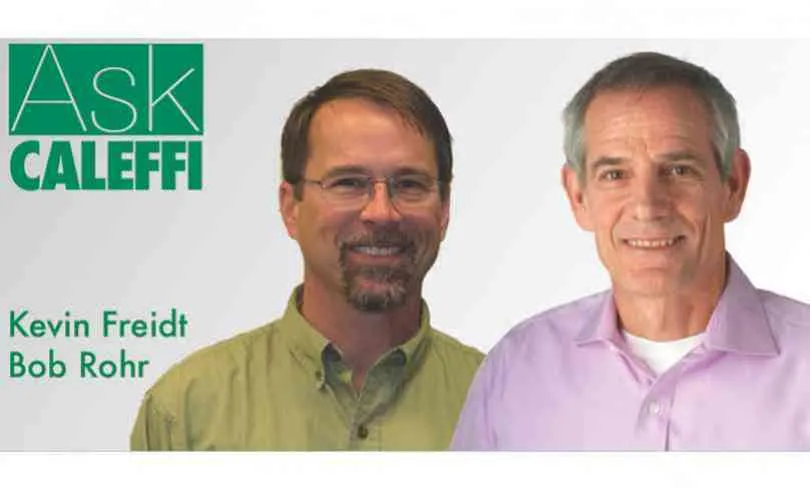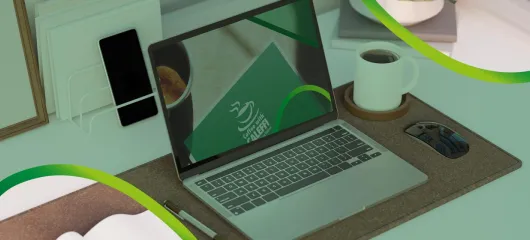ASK Caleffi Blog
Is it just me, or is good technical support hard to find these days? How do you locate - and actually talk to - the right person with the right answers? It’s tough!
Here at Caleffi, our tech support team - Kevin, Nick, Woody, Bob, Mike and Rex - have over 150 combined years of experience in our industry. We are here to answer your technical support phone calls and emails. We want to be your business partner of choice in the hydronics industry and we believe our level of experience and expertise can help us reach that goal.
In support of our dedication to your success, check out these tech support resources:
→ Our new Ask Caleffi blog featuring Bob “Hot Rod” Rohr, our training and education manager, and myself, Caleffi application engineering manager. Did I mention that you can also email us at ask.us@caleffi.com with your questions?
→ The popular Coffee with Caleffi™ webinar series. This don't-miss and FREE webinar series is a diamond in the rough!
→ Short on time but need answers? Then our YouTube video training series is just for you.
→ Need an in-depth study guide of hydronic, plumbing and renewable energy related topics and design conventions? Then idronics™ - our educational journal series for hydronic professionals - is the resource for you.
All these resources - at your fingertips - are designed to provide you with the answers and information you need to finish your projects on time and on budget. Our business commitment to our Representatives, Wholesalers, Engineers, Contractors and OEM partners has never been more focused.
Get to know us, we will help you grow your business!
Take a look at the monthly featured questions:
| Month | Question | Answer |
| Aug 2014 |
What should the pressure be in a typical solar hot water system loop? |
About 20 psi at the loop’s highest point is a good pressure. This pressure keeps the system working properly and reduces the likelihood of the glycol flashing to steam in the collector. Add 5 psi per floor between the collectors and the top of the storage tank. For example, if the tank is in the basement of a 1-story house and the collectors are on the roof, charge to 30 psi. Adjust the expansion tank to equal the loop pressure. |
| July 2014 |
I’m trying to configure a heat dump function in your iSolar™ controller and I can’t seem to get the associated relay output to come on. My set points and all the conditions look right, based on the Installation Instructions. Why won’t the relay energize? |
The storage tank has to be satisfied (up to its max temperature set point) before the heat dump will activate. This makes sense, since you would not want to dump heat if your storage tank is not yet up to temperature. |
| June 2014 |
I want to control a solar system circulator that has greater than 1 amp current draw (the rating of your iSolar™ relay output); what are my options? |
The best option is to use the Caleffi NA15012 solid state relay (SSR). It can control a load that has a current draw of up to 5 amps, and it is compatible with the iSolar speed control output functionality (pulsed 120VAC). Connect the iSolar controller output (R1, R2, etc.) to the SSR “input” terminals and run a separate 120 VAC circuit through the SSR “load” terminals to run the circulator. Another option for on/off pump control only (not speed control), is to use a common “RIB” or “ice cube” type relay. These relays cost less than SSR relays and will not work with pulsed 120 VAC. The pump minimum speed (nMN) setting in the iSolar controller must be set to 100% when using this type relay. |
| May 2014 |
The temperature sensor that are on my solar collectors is going to be about 200 feet from my iSolar™ controller. What kind of extension wire should I use and how will that affect my reading? |
The Caleffi iSolar temperature sensors are PT1000 type (1000 ohms resistance at 32 °F). Adding 200 feet of AWG 24 wire (standard hookup wire, 2.6 ohms/100 ft.) would add about 5 ohms resistance to the circuit. That added resistance will cause the controller to read about 2.3 °F high. For sensing collector temperature, that should be acceptable. |
|
April |
What does Status During Priority mean on your new ZVR Series Zone Switching Relay, and how does it work? |
The Status During Priority jumper is located just above the System Pump terminals and it affects the system pump operation when priority mode is active. When this status jumper is positioned to ON, the system pump will continue to operate during priority demand. If OFF, the system pump will not operate during a priority demand. Related: Priority is a jumper located just above the Zone 1 terminals and affects Zone 1 operation. When this priority jumper is positioned to ON (upon demand), Zone 1 will operate and all other zones are temporarily switched off (with 1 hour time-out). When the priority jumper is OFF, Zone 1 does not operate as priority. Any zone that sees a demand will operate. |
|
March |
My Caleffi 573 Series backflow preventer is dripping from the atmospheric vent; is it supposed to do this? |
A dual-check, continuous pressure backflow preventer (BFP) with atmospheric vent protects drinking water systems from return flow, caused by back-siphoning or back pressure of contaminated fluids. BFPs certified to standards CSA B64.3 and ASSE 1012, such as the 573 Series, are designed to discharge from the vent any time the inlet (upstream) water pressure drops to equal or less than the outlet (downstream) system pressure, even for a moment. If/when this occurs, the diaphragm in the body opens and the water contained in the valve body discharges from the vent. A few conditions can cause this pressure imbalance to happen. If the upstream water is being supplied by a well pump that has an “on” set point too close to the pressure setting for the system, the upstream and downstream pressures across the 573 may temporarily equalize and the vent will open. Water hammer is another condition which causes a temporary pressure imbalance and leads to vent discharge; a simple dishwasher solenoid valve can cause water hammer. Finally, lime scale or sand/sediment buildup on the seals of the check valves can causing dripping. See details in the 573 Series Installation Instructions. The 573 is easy to clean and can quickly be removed from the system as long as it is installed with isolation valves per the installation instructions. Watch our YouTube video for a good explanation of the 573, and the AutoFill™ Combo. |
|
Feb 2014 |
I’m looking at your Flow Capacity tables in Section 1 of the List Price Catalog to select the right size hydraulic separator for my job. What GPM do I use? Do I add my primary GPM and secondary GPM together? Use my primary GPM? My secondary GPM? |
Sizing is straightforward. First, determine the maximum flow rate that will exist in both the primary (boiler circuit) and secondary (distribution system). Use the greater of the two to determine the pipe size of the hydraulic separator using the Flow Capacity table. |
|
Jan 2014 |
Are the resistors that come with your Z-one™ actuators really necessary, and if so, why? |
The resistor comes with our 24V actuators which have Reed-type auxiliary switches; the resistor protects the auxiliary switch from voltage spikes associated with capacitors commonly found on relay boards. The resistors we provide are 47 Ohm, 0.5W, but any 10 to 50 Ohm resistor will do. |
|
Dec 2013 |
What is the bottom knob for on the 553 Series AutoFill™? The "+" and "-" are confusing. What position do I leave it in once I've filled the system? |
The knob is a shut-off valve; turning it clockwise (the "+" direction) closes the valve and isolates the fill water from the system. When filling the system, open the valve fully (counterclockwise, or "-"). When the system is filled, the shut-off valve can be closed. In order to restore the automatic "topping-off function", simply re-open the shut-off valve. The pressure in the system will gradually return to the set pressure. The knob is also a handy "tamper proof" means to shut off the fill valve for installers that prefer that mode. |












